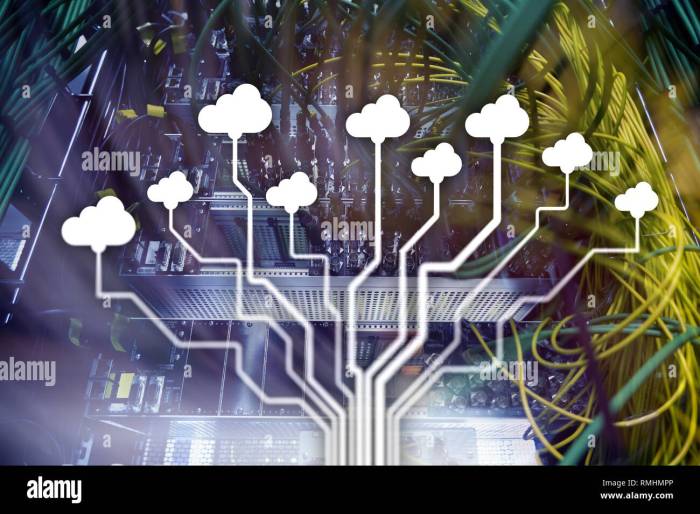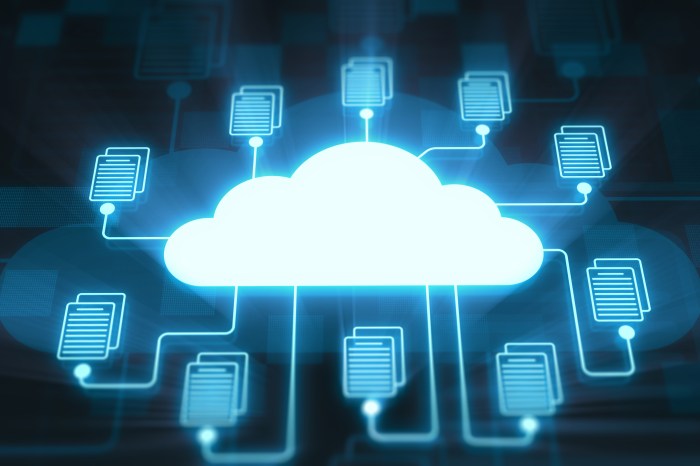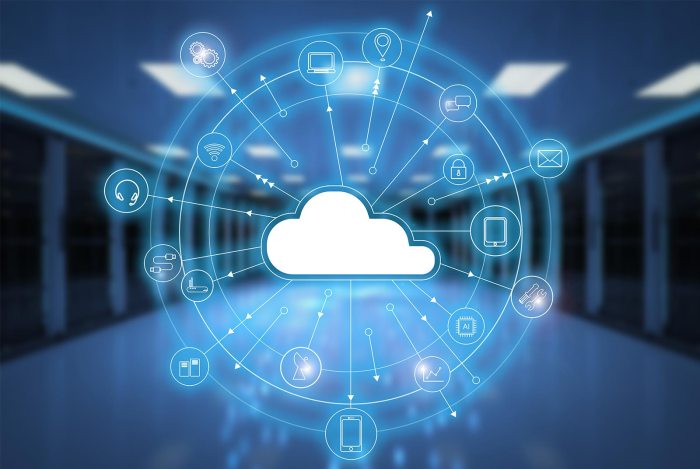Cloud computing server technology is, like, totally changing the game. We’re talking about how companies and individuals store and access data, run applications, and basically power the internet. It’s not just about servers in a room anymore; it’s about massive networks of virtualized resources, accessible from anywhere with an internet connection. This deep dive explores the nuts and bolts of this tech, from different deployment models to the latest security practices.
We’ll cover the core components, different types of cloud deployments (public, private, hybrid, and multi-cloud), and how virtualization makes all this possible. Think about the hardware, the software, the security measures—it’s all interconnected. We’ll even look at the big players like AWS, Azure, and GCP, comparing their offerings and helping you understand which might be the best fit for your needs.
Get ready to level up your understanding of cloud computing!
Server Hardware and Infrastructure

Cloud computing relies on massive server infrastructure to deliver its services. Understanding the underlying hardware and architecture is crucial to grasping the power and scalability of the cloud. This section dives into the physical components and infrastructure that make cloud computing possible.
At the heart of any cloud server lies a collection of essential hardware components working in concert. The performance and capabilities of a cloud server are directly tied to the specifications of these components.
Typical Hardware Components of a Cloud Server
Cloud servers, whether virtual or physical, are built upon standard hardware components, albeit often with higher-end specifications than your average desktop computer. These components work together to provide the computing power, storage, and networking capabilities required for cloud services.
The key components include:
- CPU (Central Processing Unit): The “brain” of the server, responsible for executing instructions and performing calculations. Cloud servers often utilize powerful multi-core processors to handle numerous concurrent tasks.
- RAM (Random Access Memory): Volatile memory that stores data actively being processed by the CPU. Larger amounts of RAM allow servers to handle more concurrent operations and improve performance. Cloud servers typically have significant RAM capacities.
- Storage: This encompasses various types of storage, including hard disk drives (HDDs), solid-state drives (SSDs), and specialized storage technologies discussed in the next section. Storage capacity is a major factor determining a server’s ability to store data and applications.
- Networking: High-speed network interfaces are essential for cloud servers to communicate with each other and with external networks. This involves network interface cards (NICs) and connections to high-bandwidth networks within the data center.
The Role of Server Farms and Data Centers
Cloud servers don’t exist in isolation. They reside within massive data centers, often referred to as server farms, which house thousands, even millions, of servers. These data centers are strategically located globally to ensure low latency and high availability. They are equipped with robust power supplies, cooling systems, and security measures to ensure the continuous operation of the servers.
The scale of these data centers is a defining characteristic of cloud computing, allowing for immense scalability and redundancy. For example, Amazon Web Services (AWS) operates numerous massive data centers across the globe, each capable of handling massive workloads.
Different Storage Solutions in Cloud Servers
Cloud storage solutions are diverse, catering to various needs and performance requirements. The choice of storage type impacts cost, performance, and data management strategies.
Three primary types of cloud storage are:
- Object Storage: Stores data as objects, each identified by a unique key. This is ideal for unstructured data like images, videos, and backups. Examples include Amazon S3 and Google Cloud Storage.
- Block Storage: Provides raw storage capacity that can be formatted and used as a hard drive. It’s often used for virtual machine (VM) instances, offering high performance for applications requiring fast access to data. Examples include Amazon EBS and Azure Disk Storage.
- File Storage: Organizes data into files and directories, providing a familiar file system interface. This is suitable for applications requiring shared file access, collaboration, and standard file management. Examples include Amazon EFS and Google Cloud Filestore.
Physical and Logical Architecture of a Cloud Server
Imagine a diagram showing a physical server rack (a metal frame holding multiple servers) within a data center. Each server in the rack contains the hardware components (CPU, RAM, storage, NIC). These physical servers are interconnected via a high-speed internal network within the data center. Logically, these physical servers are then further divided into virtual servers (VMs) through virtualization technology.
Each VM gets a slice of the physical server’s resources (CPU, RAM, storage) and appears as a separate, independent server to the user. This allows for efficient resource utilization and scalability. The VMs are then accessible through the data center’s network, and ultimately, the internet. The diagram would visually represent this layering, from the physical hardware at the bottom to the logical VMs at the top, connected via network layers.
This logical separation allows for flexibility and isolation between different users and applications.
Security in Cloud Computing Servers

Cloud computing offers incredible scalability and flexibility, but it also introduces a whole new set of security challenges. Because you’re sharing resources with other users, and relying on a third-party provider for much of your infrastructure, securing your cloud server environment requires a proactive and multi-layered approach. Ignoring security can lead to significant financial losses, reputational damage, and legal repercussions.
Common Security Threats and Vulnerabilities
Cloud environments are susceptible to a wide range of threats, many stemming from the shared responsibility model inherent in cloud computing. These threats can be broadly categorized as internal (e.g., negligent employees) or external (e.g., hackers). For example, misconfigured security settings, like overly permissive access controls, are common vulnerabilities that can expose sensitive data. Another frequent problem is insufficient patching of operating systems and applications, leaving servers vulnerable to known exploits.
Data breaches, resulting from malicious attacks or accidental exposure, are a significant concern. Furthermore, denial-of-service (DoS) attacks can cripple server availability, impacting business operations. Insider threats, from malicious or careless employees, also pose a considerable risk.
Security Best Practices for Protecting Cloud Servers
Robust security requires a layered approach combining various measures. Access control is paramount, limiting access to only authorized users and systems using techniques like multi-factor authentication (MFA) and role-based access control (RBAC). Encryption, both in transit (using HTTPS) and at rest (encrypting data stored on disks), is crucial to protect data confidentiality. Regular patching and updating of software and operating systems are essential to mitigate vulnerabilities exploited by attackers.
Implementing a strong security information and event management (SIEM) system helps monitor activity, detect anomalies, and respond to incidents promptly. Regular security audits and penetration testing can identify weaknesses before attackers exploit them. Finally, adhering to compliance standards, such as HIPAA or PCI DSS, depending on the nature of the data being handled, is essential for many organizations.
Comparison of Security Models in Cloud Computing
Different cloud providers and deployment models offer varying levels of security responsibility. In the shared responsibility model, the cloud provider is responsible for securing the underlying infrastructure (the “cloud”), while the customer is responsible for securing their own data and applications running on that infrastructure. This differs from on-premise environments, where the organization is fully responsible for all aspects of security.
The shared responsibility model is crucial to understand as it directly impacts the security measures an organization needs to implement. For example, a provider might offer encryption at rest, but the customer might still need to manage encryption in transit and access controls for their applications. Different cloud models (IaaS, PaaS, SaaS) also impact the level of security responsibility shared between provider and customer.
Security Measures for a Cloud Server Environment
Implementing a comprehensive security strategy is crucial. A robust approach necessitates a combination of preventative and reactive measures.
- Implement strong access controls: Utilize multi-factor authentication (MFA) and role-based access control (RBAC) to restrict access to sensitive resources.
- Encrypt data both in transit and at rest: Employ HTTPS for secure communication and encrypt data stored on disks using strong encryption algorithms.
- Regularly patch and update systems: Maintain up-to-date software and operating systems to mitigate known vulnerabilities.
- Utilize a security information and event management (SIEM) system: Monitor system activity, detect anomalies, and respond to security incidents promptly.
- Conduct regular security audits and penetration testing: Identify and address security weaknesses proactively.
- Implement intrusion detection and prevention systems (IDPS): Detect and block malicious network traffic.
- Establish a robust incident response plan: Define procedures for handling security breaches and minimizing their impact.
- Employ a virtual private cloud (VPC): Isolate your cloud resources from other users’ resources to enhance security.
- Monitor cloud resource usage and configurations: Identify potential security risks through regular monitoring and logging.
- Comply with relevant industry regulations and standards: Adhere to compliance standards such as HIPAA, PCI DSS, or GDPR as needed.
Emerging Trends in Cloud Computing Server Technology

The cloud computing landscape is constantly evolving, driven by advancements in hardware, software, and user demands. New trends are reshaping how we build, deploy, and manage server infrastructure, leading to greater efficiency, scalability, and cost optimization. This section will explore some of the most significant emerging trends, their impact, and real-world applications.
Serverless Computing
Serverless computing represents a paradigm shift in application development and deployment. Instead of managing servers directly, developers focus solely on writing and deploying code, which is then executed by the cloud provider’s infrastructure on demand. This eliminates the need for server provisioning, scaling, and maintenance, allowing developers to concentrate on core functionality. Popular serverless platforms like AWS Lambda, Google Cloud Functions, and Azure Functions demonstrate the growing adoption of this approach.
The benefits include reduced operational overhead, improved scalability (automatically scaling based on demand), and cost savings (only paying for the compute time used). For example, a company processing images could use a serverless function to trigger image resizing only when a new image is uploaded, minimizing costs associated with constantly running a server.
Edge Computing
Edge computing brings processing power closer to the source of data, reducing latency and bandwidth requirements. This is particularly crucial for applications requiring real-time responses, such as IoT devices, autonomous vehicles, and augmented reality experiences. Instead of sending all data to a central cloud data center, processing occurs at the edge, on devices like gateways or local servers.
This minimizes delays caused by data transmission over long distances, improving performance and responsiveness. For instance, a smart city deploying numerous sensors for traffic management would benefit from edge computing to process data locally, enabling faster traffic light adjustments and improved traffic flow.
Artificial Intelligence and Machine Learning in Cloud Server Management, Cloud computing server technology
AI and ML are transforming cloud server management, automating tasks and improving efficiency. These technologies are used for predictive maintenance, identifying potential issues before they impact performance, optimizing resource allocation based on real-time demand, and automating security monitoring and threat detection. For example, ML algorithms can analyze server logs to predict potential hardware failures, allowing for proactive replacement and minimizing downtime.
AI-powered chatbots are also being deployed for automated customer support and troubleshooting, enhancing user experience.
Cloud Computing Server Technology in Various Industries
Cloud computing is revolutionizing numerous industries. In healthcare, it facilitates secure storage and sharing of patient data, enabling better collaboration among medical professionals. Financial institutions leverage cloud services for high-speed transaction processing and fraud detection. Retailers use cloud-based analytics to personalize customer experiences and optimize supply chains. The manufacturing sector employs cloud computing for real-time monitoring of equipment and predictive maintenance, maximizing production efficiency.
The entertainment industry uses cloud platforms for content delivery, streaming services, and game development.
Timeline of Cloud Computing Server Technology Evolution
The evolution of cloud computing server technology can be visualized as a timeline marked by significant milestones. The early 1990s saw the emergence of the concept of utility computing, laying the foundation for the cloud. The late 1990s and early 2000s witnessed the rise of application service providers (ASPs) offering software as a service (SaaS) solutions. Amazon Web Services (AWS) launched in 2006, marking a pivotal moment, ushering in the era of Infrastructure as a Service (IaaS) and Platform as a Service (PaaS).
The following years saw rapid growth and innovation, with the introduction of various cloud platforms, containerization technologies (like Docker and Kubernetes), and serverless computing. The 2010s and beyond have been characterized by increasing adoption of AI and ML in cloud management, edge computing, and the development of hybrid and multi-cloud strategies. This continuous evolution reflects the ever-growing demand for scalable, reliable, and cost-effective computing solutions.
So, there you have it—a whirlwind tour of cloud computing server technology! From the basic components to the cutting-edge trends, we’ve covered a lot of ground. Understanding cloud technology isn’t just for techies anymore; it’s becoming increasingly relevant for everyone. Whether you’re a student, a business owner, or just curious about how the internet works, grasping the fundamentals of cloud computing can give you a serious advantage.
Remember, the cloud is constantly evolving, so stay curious and keep learning!
Key Questions Answered
What’s the difference between IaaS, PaaS, and SaaS?
IaaS (Infrastructure as a Service) is like renting the raw server hardware. PaaS (Platform as a Service) provides a platform for building and deploying apps, and SaaS (Software as a Service) is software accessed over the internet (like Gmail).
How secure is cloud computing?
Cloud providers invest heavily in security, but it’s crucial to implement best practices on your end, too. This includes strong passwords, encryption, and regular security updates.
Is cloud computing expensive?
It depends on your needs and usage. Cloud computing can be very cost-effective, especially for scaling up and down as needed, but it’s important to monitor your usage to avoid unexpected bills.
What are some examples of cloud server applications?
Tons! Think email services, online databases, social media platforms, streaming services – basically anything that needs to handle a lot of data and users.